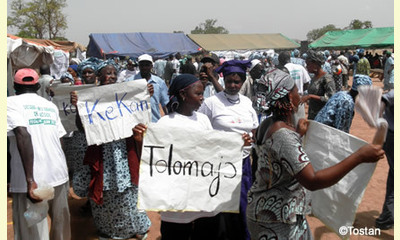|
|
Female Circumcision Declining in Africa, but 30 Million Girls Still at Risk
un article par Aid for Africa
A new report by UNICEF finds that the
practice of female genital cutting (FGC), which
started centuries ago, has been declining in
Africa. But even where laws now forbid it,
circumcising girls by removing part or all of
their external genitalia continues. In this
century, some 30 million girls remain at risk.

click on photo to enlarge
Many organizations, including Aid for Africa
member Tostan, whose name means
“breakthrough,” have been working to end this
practice, which can cause death, puts mother and
child at risk during birth, and leads to
additional chronic health problems for a woman.
Why does the practice persist? Molly Melching, the
executive director of Tostan, which has been
working since the 1970s to end FGC and
child/forced marriage in West Africa, explained at
a recent meeting that genital cutting is an
entrenched tradition that is society-wide in many
African countries. Many women are unaware of the
grave risks and believe that their daughters will
not be marriageable without it. The result: ending
genital cutting by narrowly focusing only on the
practice has not worked. For social cohesion, it
takes an entire community to make the decision,
according to Melching.
So when women, men, young children, and teenagers
from 30 villages in the West African nation of
Mali gathered on the banks of the Niger river this
past June to publicly declare the abandonment of
FGC and child/forced marriage in their
communities, there was much to celebrate. Similar
declarations were made in May by 92 communities in
Guinea and in June in Senegal and The Gambia by
more than 280 communities.
Tostan had worked with members of these
communities to help them better understand their
basic rights, the rights of women and a woman’s
right to make decisions affecting her health.
Using storytelling, theater and other shared
events, communities were able to come together to
discuss democracy, human rights and health and
make shared decisions on genital cutting and other
issues.
The UNICEF study found that where FGC is practiced,
most women think it should end. Even so, many chose
the traditional path. With 30 million girls still at
risk, there is still much to do.
How can you help?
[Note: Thank you to Janet Hudgins, the CPNN reporter
for this article.]
|








|
DISCUSSION
Question(s) liée(s) à cet article:
Protecting women and girls against violence, Is progress being made?
* * * * *
Commentaire le plus récent:
The 47 CPNN articles devoted to this theme suggest that indeed progress is being made.

|
|









